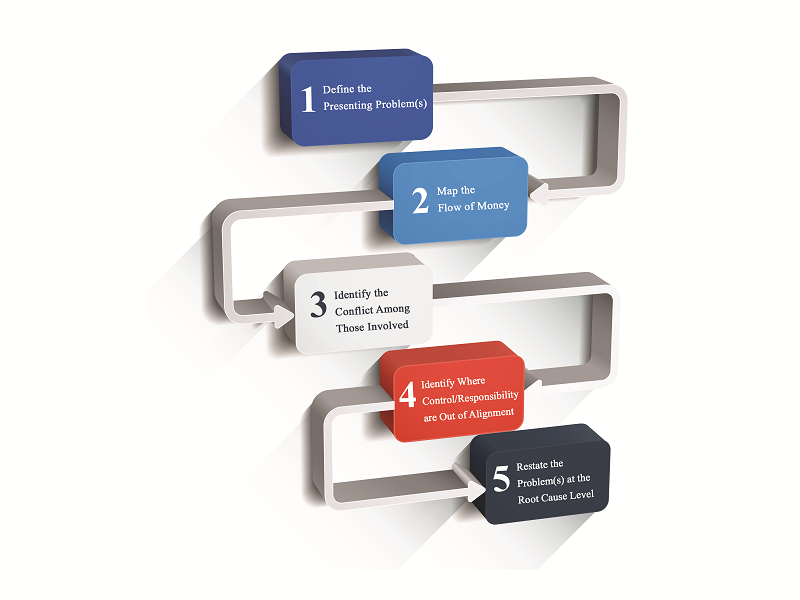A Systematic Approach Using Enterprise Energy

It is truly amazing to me how often companies, schools and government agencies misdiagnose their organizational problems and needs. Incredibly, misdiagnosis happens most of the time. The reason is that our typical view of a business, (what we can see at the surface), and our understanding of how it works, (a surface-level understanding), is very limited. Managers and change leaders do the best they can with what they’ve got. Unfortunately, however, their limited view usually leads them to conclude that the symptoms they see on the surface are the problems to be solved. They seldom identify the real root cause problem – the deeper organizational diagnosis.
How do I know this? I know this because, over my many years of leading and teaching business transformation, I developed a much more informed method of diagnosing organizations. It involves a deeper and more insightful look into an organization – beneath the surface. This systematic approach has never failed me. It’s like an X-ray machine for business, but you have to be willing to think outside of the box.
What is this out-of-the-box thinking? The answer is that you have to look at your organization through the lens of energy. Yes, energy. You can read all about it in my recently published book, The Energy Equation: Unlocking the Hidden Power of Energy in Business. Meanwhile, this article will introduce you to the general methodology and practice of using energy to accurately diagnose organizational problems and needs. It will also point you to some valuable resources for implementing the methodology on change initiatives in your own organization.
Methodology For Uncovering The Deeper Organizational Diagnosis
The best way to understand the methodology for uncovering the deeper organizational diagnosis is to read the details and examples in the book. However, for the purpose of this article, a short summary follows.
 1) Define the Presenting Problem
1) Define the Presenting Problem
Start by documenting the presenting problem(s). Presenting problems are the things we can see and observe. They serve as indicators of energy and a starting point for our process. There is no analysis in this step, only clear observation. How are the affected people behaving, in general? Describe the current states of performance, productivity, etc. Characterize your observations about morale, attitudes and anger levels. Identify the things that are not working? Whatever it is, just state the observations.
2) Map the Flow of Money
Map the flow of money through the problem area and supporting areas to understand how the function currently “works.” Money is a form of energy, and it can either help drive positive change or anchor the business in its status quo. How does the flow of money reinforce current behaviors and contribute to the problems? Does the flow of money empower or dis-empower those involved? Keep in mind that changing the way money flows is potentially a part of your solution.
3) Describe the Conflict Among Those Involved
Characterize the conflict among those involved in the problem area using available information and your own insights. Conflict creates negative energy, which drags the business down. It is also an indicator of the deeper problem. Boil the conflict down to what is most important. What are the behavioral patterns? What people and groups are in conflict? Are there types of conflict that regularly occur?
4) Identify the Misalignment Between Control and Responsibility
Based on the results of the first three steps, you now have a good understanding of how things work, and where they are broken. On that basis, you are now prepared to identify where control and responsibility are out of alignment. This is generally where a function or group of people in the company, (e.g., Program Managers) are responsible for something, (e.g., program success) but don’t have the control necessary to execute on that responsibility, (e.g., inadequate budget and control over team members). You know you have it right when it explains where the symptoms, dysfunction and conflict originate.
There is usually one overarching misalignment of control and responsibility in any major problem, and everything else is a supporting actor. Find that one misalignment and clearly state it.
5) Restate the Problem at the Root Cause Level
This step requires your analysis and insight. The answer may be obvious, or it may require a deeper contemplation. The misalignment between control and responsibility will lead you to the root cause problem. However, think bigger picture here. Perhaps the business is using the wrong paradigm, (e.g., an individual selling model vs. a team selling model, or a functional orientation vs. a program/team orientation). Find the overarching cause of the problem and explain how it is the source of the presenting problem(s) described in Step 1.
What You Will Find

Whenever I employ this methodology for uncovering the deeper organizational diagnosis, which I have done dozens of times, here is what I find, and what I think you will find too if you choose to use it.
- I have a much deeper understanding of how the department or enterprise function works, and doesn’t work.
- The root cause is different, usually significantly different, than what it appeared to be going into the diagnostic process.
- I have a new level of confidence that I’ve gotten to the bottom of the problem.
- My solution will be very different than what it would have been if I hadn’t gone through this deeper diagnostic methodology.
- I now know where and how the flow of energy is sub-optimal, and can design a solution to optimize that flow.
- I’m a happy camper, knowing that I am right on track with this change initiative.
Design Your Solution
Based on all of that, you are absolutely ready to design your organizational solution. For some tips and techniques on how to do that, using energy of course, see my last article: Revolutionizing Change Management: Change Management by Design.
Get Our Toolset at No Cost
We developed the Enterprise/Department Analysis and Design Toolset to guide you in applying the diagnostic methodology, as well as in designing and developing an effective organizational solution. It’s based on The Energy Equation, so you will need both to get started. The great news is that we will send you the toolset at no cost when you buy the book!
